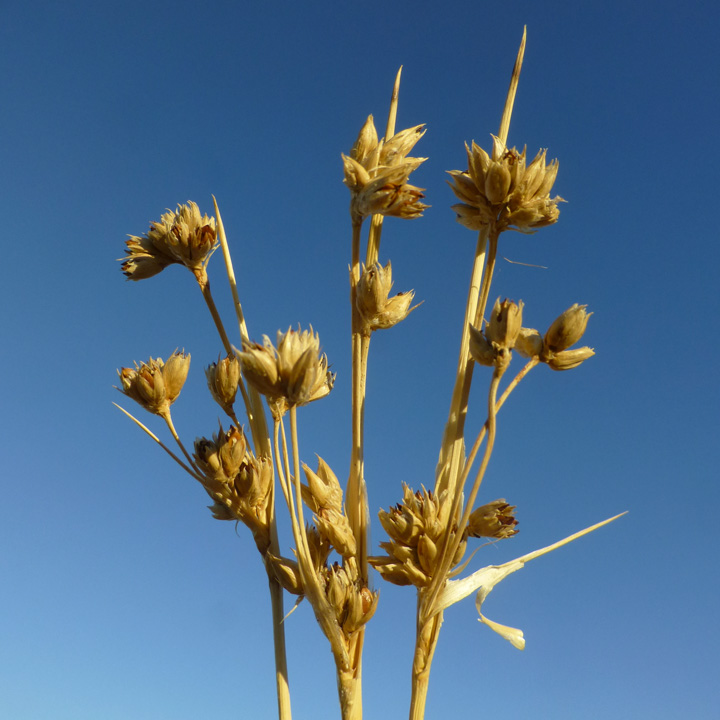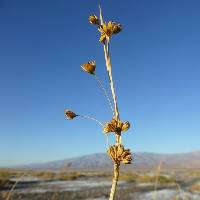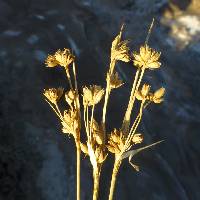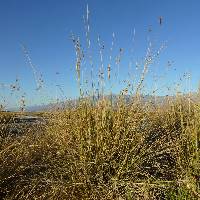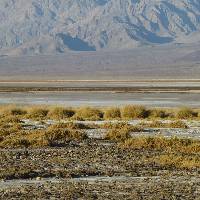|
|
|
|
Family: Juncaceae
Cooper's rush
|
Herbs, perennial, robust, tufted, 4--10 dm. Rhizomes short. Culms terete, 1.5--2.5 mm diam. Cataphylls several, reddish brown, often apiculate. Leaves basal, 1--2; auricles essentially absent; blade terete, 10--40 dcm, shorter than culm. Inflorescences glomerules 3--12, each with (1--)2--5 flowers, open, branches unequal, 3--12 cm, primary bract terete or slightly compressed, shorter to longer than inflorescence. Flowers: tepals straw-colored to pale green, ovate-lanceolate, 4--5 mm, apex acuminate or setaceous; inner series elliptic, nearly equal, margins wide, scarious, apiculate; stamens 6, filaments 1 mm, anthers 1.5--2 mm; style 1 mm. Capsules tan to light reddish brown, 3-locular, ellipsoid, 3.7--4.5 x1.6--2 mm, mostly shorter than or nearly equal to perianth. Seeds dark amber, obovoid, body 0.7--1 mm, tails 0.1--0.5 mm. Flowering and fruiting spring--summer. Saline flats and meadows or edges of salt marshes; below 600 m; Ariz., Calif., Nev., Utah; Mexico. FNA 2000, Kearney and Peebles 1969, Wiggins 1964 Common Name: Cooper's rush Duration: Perennial Nativity: Native Lifeform: Graminoid General: Robust tufted perennial herb with short rhizomes, 40-100 cm tall. Vegetative: Culms terete, 1.5-2.5 mm in diameter, with several reddish brown cataphylls that are often apiculate, 1-2 basal leaves, no real auricles; light green blade stiff, spinescent, terete, 10-40 cm, shorter than stem. Inflorescence: Compound panicle of glomerules 3-12, each with 2-5 flowers, open with unequal branches, 3-12 cm; the primary bract terete or slightly compressed, shorter to longer than inflorescence; tepals straw-colored to pale green, ovate-lanceolate, 4-5 mm, apex acuminate or setaceous; inner series elliptic, nearly equal, margins wide, scarious, apiculate; 6 stamens, the filaments 1 mm, anthers 1.5-2 mm, and style 1 mm; capsules tan to light reddish brown, 3-locular, ellipsoid, 3.5-4.5 mm long by 1.5-2 mm wide. Ecology: Found in saline flats, and along the edges of meadows and salt marshes below 2,000 ft (610 m); flowers May-September. Notes: Distinguished by its habitat and by the acute perianth segments which are narrowly scarious margined, greenish or straw colored, and 4-6 mm long, which equal the capsule generally. Ethnobotany: Unknown Etymology: Juncus comes from the Latin jungere, to join or bind, while cooperi is named for Dr. James Graham Cooper (1830-1902) a geologist. Synonyms: None Editor: SBuckley, 2010 |


